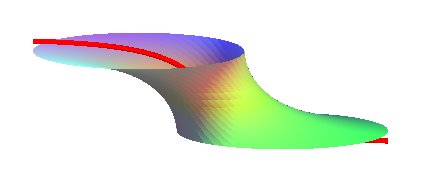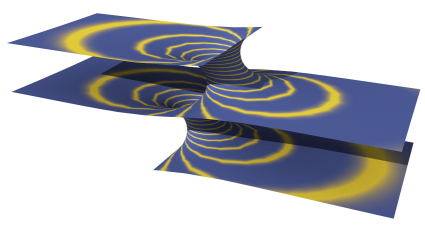SKEW CATENOID, RIEMANN'S MINIMAL SURFACE

| next surface | previous surface | 2D curves | 3D curves | surfaces | fractals | polyhedra |
SKEW CATENOID, RIEMANN'S MINIMAL SURFACE

| Surface studied by Riemann in 1860, Enneper in 1869.
Bernhard Riemann (1826 - 1866): German mathematician. Ref: [NITSCHE] p. 84. |
| Cartesian parametrization: Horizontal circles with radius u centered on Nota: the integrals above can be computed thanks to elliptic functions. |
The skew catenoid with equation given above is
the solution to the problem that consists in finding the circledminimal
surfaces. Note that the circles are therefore, necessarily, parallel
to one another, and the line composed of the centers of the circles is
traced on a plane perpendicular to the planes of the circles.
The skew catenoid provides also a solution to the Plateau
problem that consists in finding a minimal surface joining two circles
located in parallel planes (but note that there are some conditions on
the circles for the surface to exist - start by considering the case of
coaxial circles at catenoid).
If we take k = 0 in the above formulas, we get
the classic right catenoid.
| The surface is located between the two planes ( Thanks to translations of the previous pattern and adjustments of the asymptotic half-planes, we get a periodic smooth minimal surface, called Riemann's minimal surface. All the sections by horizontal planes are circles or lines. |

|
See also the finite Riemann
minimal surface.
| next surface | previous surface | 2D curves | 3D curves | surfaces | fractals | polyhedra |
© Robert FERRÉOL
2017